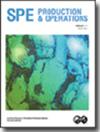Impact of Relaxation of Low-Sulfate Seawater Parameters on Scaling Risk
IF 1.3
4区 工程技术
Q2 ENGINEERING, PETROLEUM
引用次数: 0
Abstract
Injection of low-sulfate seawater (LSSW) instead of untreated full-sulfate seawater (FSSW) is widely used to mitigate barium sulfate scaling risk at the production wells. LSSW injection may no longer be required when the barium concentrations in the produced water drop below a certain threshold. Such a trigger value could be estimated from the barium sulfate precipitation tendency. Relaxation of requirements for the sulfate reduction plant (SRP) can significantly reduce operational costs. This study investigates the impact of several parameters on the timing and degree of relaxation of the output sulfate concentration by the SRP. Finally, the optimal switching strategy is proposed for a field case. The strategy for switching from LSSW to FSSW (e.g., time and method; direct or gradual increase in the sulfate concentration) was initially investigated using generic 2D areal and vertical models. The sensitivity study included the impact of reservoir heterogeneity and the initial barium and sulfate ion concentrations. Findings were later applied on a full-field reservoir simulation model followed by a mineral scale prediction software to investigate the specific switching strategy for a field that has multiple wells and significantly more complex heterogeneity. The results show that barium concentrations in the formation brine affect the choice of switching time more than the output sulfate concentration produced by the SRP. The degree of heterogeneity around the producers also has a significant impact on the switching time. Another parameter is the contrast in the permeability between layers; higher contrast allows a longer period of coproduction of the scaling ions and thus delays the switching time. In the field case, switching to FSSW at early times allows higher consumption of barium ions because of its in-situ precipitation. Barium is no longer a limiting ion, and so a higher degree of deep reservoir precipitation reduces the requirement for prolonged LSSW injection. Another strategy is a gradual relaxation of LSSW output, which allows even earlier buildup of the injected sulfate concentration compared with the direct FSSW switch. The study investigates the reservoir parameters that affect sulfate relaxation of LSSW injection for a field. After the proposed workflow, the optimal relaxation strategy can be designed for other field cases.低硫酸盐海水参数松弛对结垢风险的影响
注入低硫酸盐海水(LSSW)代替未经处理的全硫酸盐海水(FSSW)被广泛用于降低生产井的硫酸钡结垢风险。当采出水中的钡浓度降至某一阈值以下时,可能不再需要注入LSSW。这个触发值可以从硫酸钡的沉淀趋势中估计出来。放宽对硫酸盐还原装置(SRP)的要求可以显著降低运营成本。本研究考察了几个参数对SRP输出硫酸盐浓度的时间和松弛程度的影响。最后,针对一个现场案例,提出了最优切换策略。由LSSW转换为FSSW的策略(例如,时间和方法;硫酸盐浓度的直接或逐渐增加)最初使用一般的二维面积和垂直模型进行了研究。敏感性研究包括储层非均质性和初始钡和硫酸盐离子浓度的影响。研究结果随后应用于全油田油藏模拟模型,随后应用矿物规模预测软件,研究具有多口井且非均质性明显更复杂的油田的特定切换策略。结果表明,地层卤水中的钡浓度比SRP产生的硫酸盐输出浓度更能影响开关时间的选择。生产者周围的异质性程度对切换时间也有显著影响。另一个参数是层间渗透率的对比;更高的对比度允许更长的时间的协同生产的缩放离子,从而延迟切换时间。在现场情况下,由于原位沉淀,早期切换到FSSW可以增加钡离子的消耗。钡不再是限制离子,因此较高程度的深层储层沉淀减少了长时间注入LSSW的需求。另一种策略是逐渐放松LSSW输出,与直接FSSW开关相比,它允许更早地积累注入的硫酸盐浓度。研究了影响某油田LSSW注入硫酸盐松弛的储层参数。根据提出的工作流程,可针对其他现场情况设计最优松弛策略。
本文章由计算机程序翻译,如有差异,请以英文原文为准。
求助全文
约1分钟内获得全文
求助全文
来源期刊

Spe Production & Operations
工程技术-工程:石油
CiteScore
3.70
自引率
8.30%
发文量
54
审稿时长
3 months
期刊介绍:
SPE Production & Operations includes papers on production operations, artificial lift, downhole equipment, formation damage control, multiphase flow, workovers, stimulation, facility design and operations, water treatment, project management, construction methods and equipment, and related PFC systems and emerging technologies.
 求助内容:
求助内容: 应助结果提醒方式:
应助结果提醒方式:


